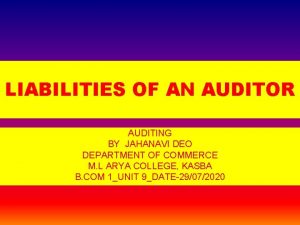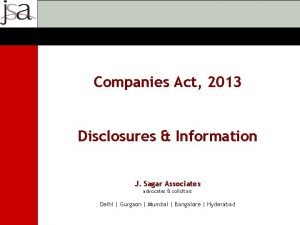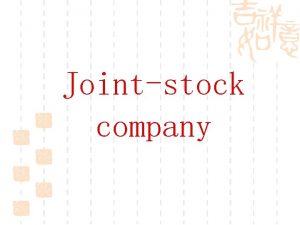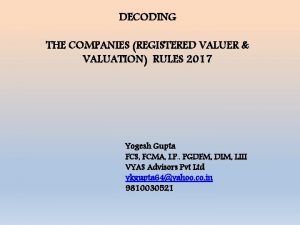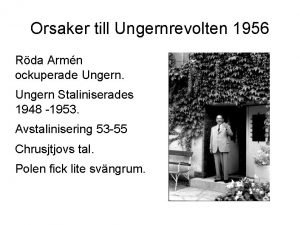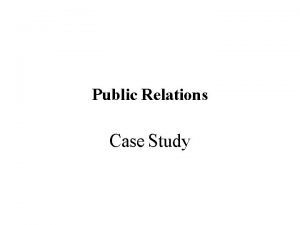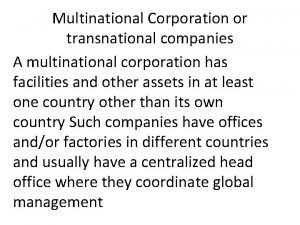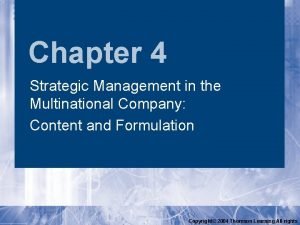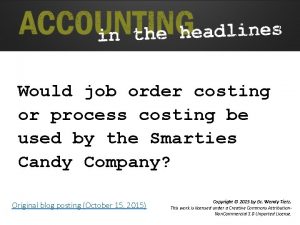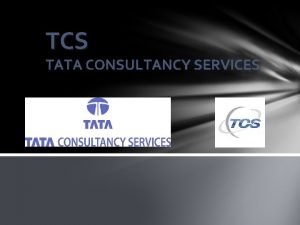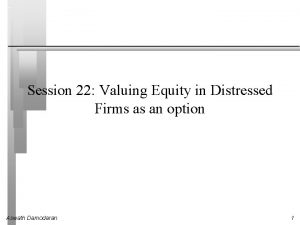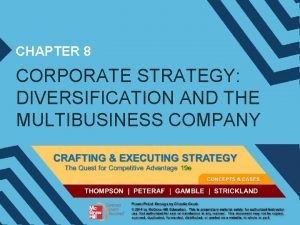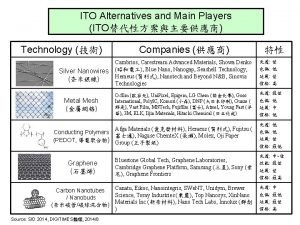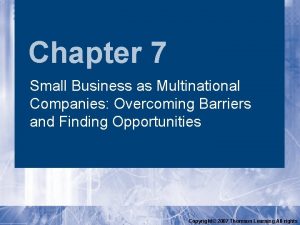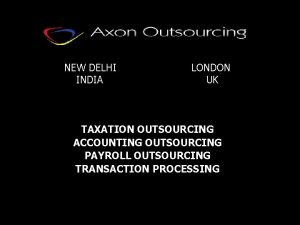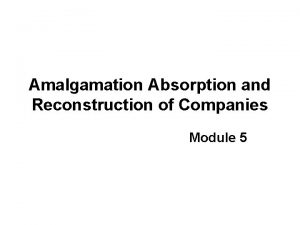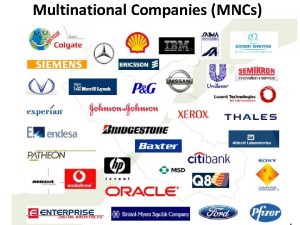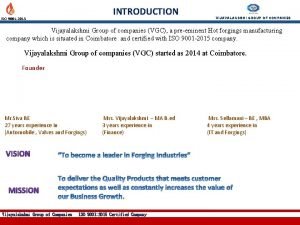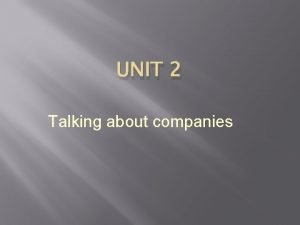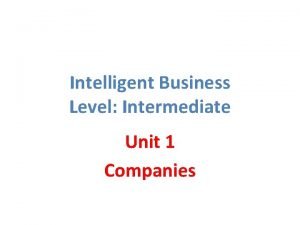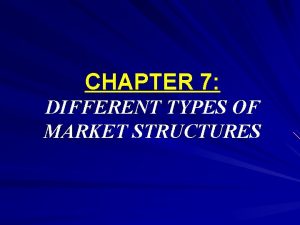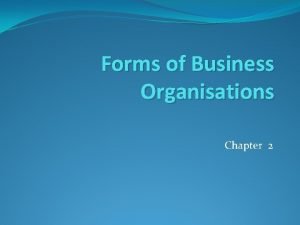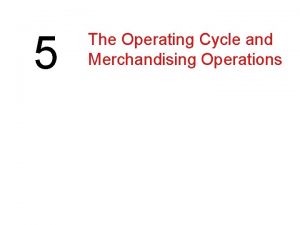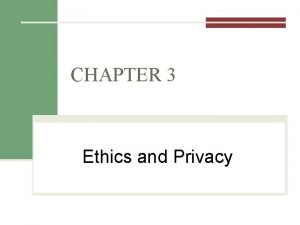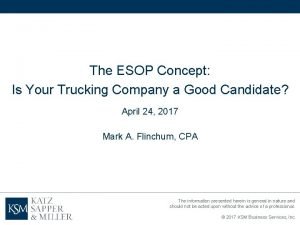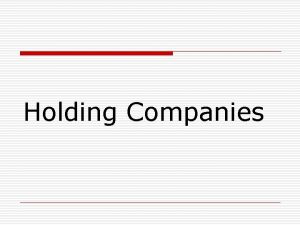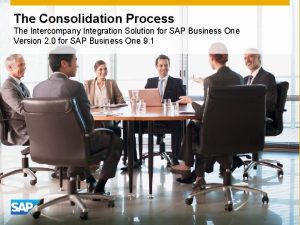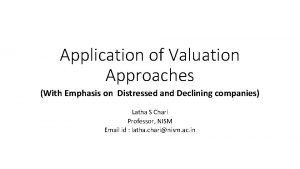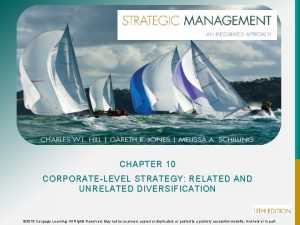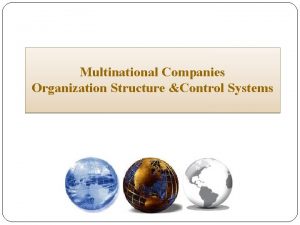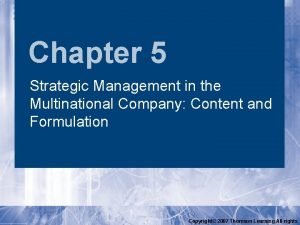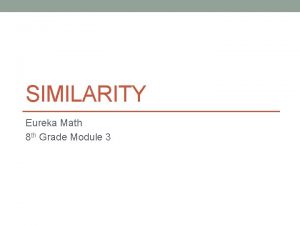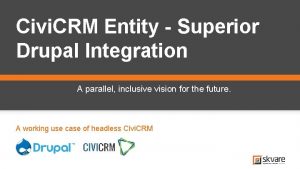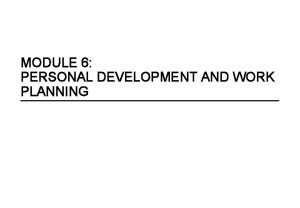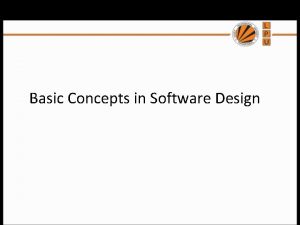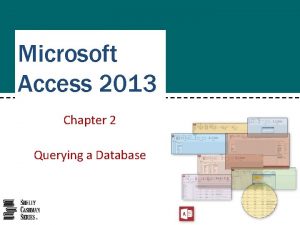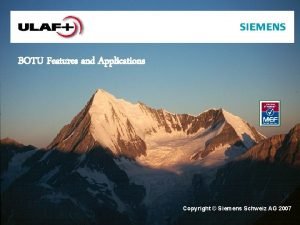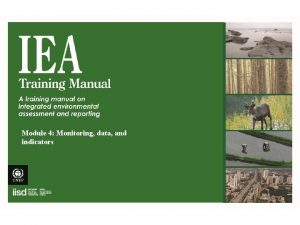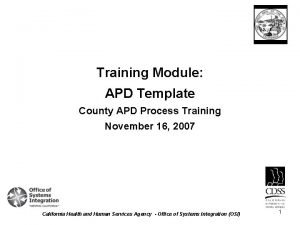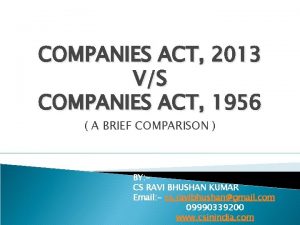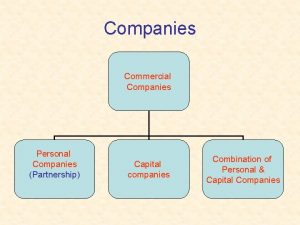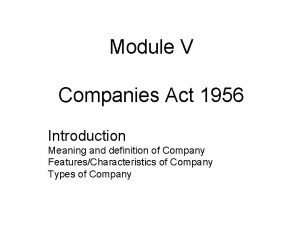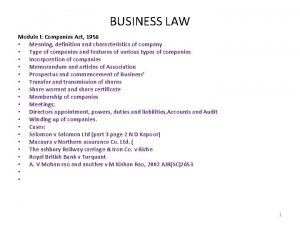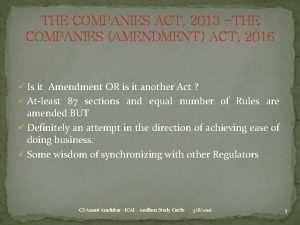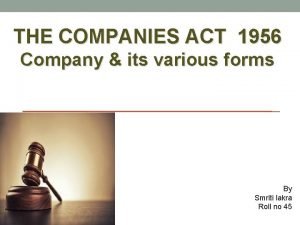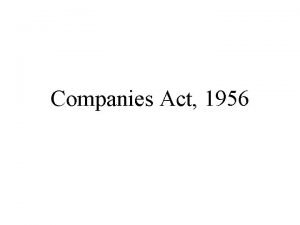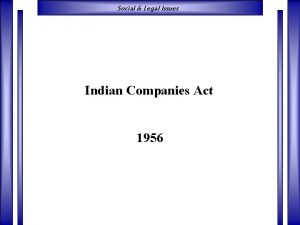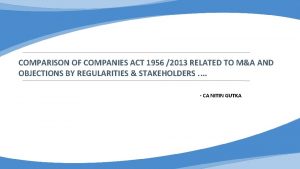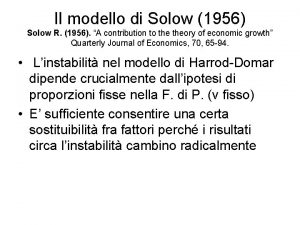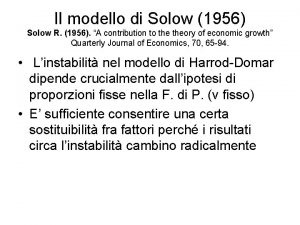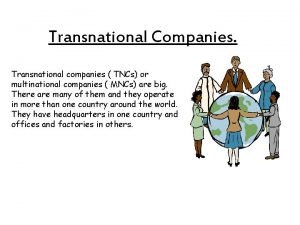Module 2 COMPANIES ACT 1956 1 What is





![Private Company [Section 3(1)(iii)] • A private company means a company which has a Private Company [Section 3(1)(iii)] • A private company means a company which has a](https://slidetodoc.com/presentation_image_h2/5867743f4285327c45e971035a86bac3/image-6.jpg)


![Public Company [Section 3(1)(iv)] • A public company means a company which: (a) is Public Company [Section 3(1)(iv)] • A public company means a company which: (a) is](https://slidetodoc.com/presentation_image_h2/5867743f4285327c45e971035a86bac3/image-9.jpg)
















![1. Name Clause[ section 13(1)(a)] • The memorandum must state the name of the 1. Name Clause[ section 13(1)(a)] • The memorandum must state the name of the](https://slidetodoc.com/presentation_image_h2/5867743f4285327c45e971035a86bac3/image-26.jpg)
![2. Registered office clause [section 13(1)(b)] • The state in which the registered office 2. Registered office clause [section 13(1)(b)] • The state in which the registered office](https://slidetodoc.com/presentation_image_h2/5867743f4285327c45e971035a86bac3/image-27.jpg)
![3. Object Clause section 13(1)(c)&(b)] This clause is quite important and must be very 3. Object Clause section 13(1)(c)&(b)] This clause is quite important and must be very](https://slidetodoc.com/presentation_image_h2/5867743f4285327c45e971035a86bac3/image-28.jpg)
![4. Liability Clause[section 13(2)] Ø This clause states the nature of liability of the 4. Liability Clause[section 13(2)] Ø This clause states the nature of liability of the](https://slidetodoc.com/presentation_image_h2/5867743f4285327c45e971035a86bac3/image-29.jpg)
![5. Capital Clause[section 13(4)(a)] • This clause states that amount of the capital with 5. Capital Clause[section 13(4)(a)] • This clause states that amount of the capital with](https://slidetodoc.com/presentation_image_h2/5867743f4285327c45e971035a86bac3/image-30.jpg)
![6. Association clause [section 13(4)(c)] • The association clause states – in this cause 6. Association clause [section 13(4)(c)] • The association clause states – in this cause](https://slidetodoc.com/presentation_image_h2/5867743f4285327c45e971035a86bac3/image-31.jpg)
















































































































![VOTING RIGHTS • EQUITY SHAREHOLDERS RIGHTS[sec. 87 (1)] : • In the case of VOTING RIGHTS • EQUITY SHAREHOLDERS RIGHTS[sec. 87 (1)] : • In the case of](https://slidetodoc.com/presentation_image_h2/5867743f4285327c45e971035a86bac3/image-144.jpg)
![• Preference share capital[sec. 87 (2)] : • The preference shareholder has voting • Preference share capital[sec. 87 (2)] : • The preference shareholder has voting](https://slidetodoc.com/presentation_image_h2/5867743f4285327c45e971035a86bac3/image-145.jpg)





































- Slides: 182

Module : 2 COMPANIES ACT 1956 1

What is a company • A company is an artificial person created by law. • A company means a group of persons associated together for the attainment of a common end, social or economic. • The company means a company formed and registered under this act or an existing company 2

Definition of a company • According to Sec (1), “A company formed and registered under the act”. • According to Sec (3) of the act, “on incorporation a company becomes a body corporate or a corporation with a perpetual succession and a common seal. ” • According to N. D. Kapoor, ” IT is a voluntary association of persons formed for some common purpose, with capital divisible into parts, known as shares, and with a limited liability. It is a creation of the law and is sometimes known as an artificial person with a perpetual succession and a common seal. IT exists only in the eyes of the law, I. e. , it is regarded by the law as person, just as a human being. But it has no physical existence. ” 3

CHARACTERISTICS OF A COMPNAY • • Separate legal entity Limited liability Perceptual succession Common seal Transferability of shares Separate property Capacity to sue 4

Types of Company 1. 2. 3. 4. 5. Private and public company Limited and unlimited company Holding and subsidiary company Government company Foreign company 5
![Private Company Section 31iii A private company means a company which has a Private Company [Section 3(1)(iii)] • A private company means a company which has a](https://slidetodoc.com/presentation_image_h2/5867743f4285327c45e971035a86bac3/image-6.jpg)
Private Company [Section 3(1)(iii)] • A private company means a company which has a minimum paid up capital of one lakh rupees or such higher paid-up capital as may be prescribed and by its articles : (a) restricts the right to transfer its shares, if any; (b) limits the number of its members to 50, (not including its employee members) 6

Private Company …contd. (i) persons who are in the employment of the company, and (ii) persons who, having been formerly in the employment of the company, were members of the company while in that employment and have continued to be members after the employment ceased; (c) prohibits invitation to the public to subscribe for any shares in or debentures of, the company; and 7

Private Company …contd. (d) prohibits any invitation or acceptance of deposits from persons other than its members, directors or their relatives. • Where two or more persons hold one or more shares in a company jointly, they shall, for the purposes of membership, be treated as a single member. 8
![Public Company Section 31iv A public company means a company which a is Public Company [Section 3(1)(iv)] • A public company means a company which: (a) is](https://slidetodoc.com/presentation_image_h2/5867743f4285327c45e971035a86bac3/image-9.jpg)
Public Company [Section 3(1)(iv)] • A public company means a company which: (a) is not a private company [In other words, it should not have the restrictions of Section 3(1)(iii) in its articles ]; (b) has a minimum paid-up capital of five lakh rupees or such higher paid-up capital, as may be prescribed; and (c) By its articles does not restricts the right to transfer its share , if any; 9

Public Company …. . con d) By its articles does not limits the number of its member (e) By its articles does not prohibits invitation to the public to subscribe for any shares or debentures of the company 10

Limited and Unlimited Companies • A limited company is one wherein the liability of its members is limited any future be subclassified as below 1. A company limited by shares 2. A company limited by guarantee 3. Unlimited companies 11

Subsidiary companies According to sec 4(7), a company is known as subsidiary company of another company when control is exercised by the later company (a) it controls the composition of its board of directors; (b) A company holding majority of shares For example: - if a company B is subsidiary of the company A, and Company C is subsidiary of the company B, therefore company C is also subsidiary of the company A 12

Holding company • According to sec 4(4), a company is known as holding company of another company if it has control over that other company 13

Government company • A Government company is one in which either the Central Government or the State Governments taken together hold not less than 51% of its paid-up capital. The term further includes a subsidiary of such a Government company. 14

1. A Government company may be incorporated as a private company or a public company. 2. A Government company is governed by the provisions of the Companies Act unless exempted by the Central Government under powers conferred under section 620. 3. The Central Government has exempted the Government companies from most of the provisions of the Companies Act. 15

A foreign company means a company incorporated outside India but having a place of business in India. ( sec 591(1)) 1. A foreign company is required to furnish to the Registrar documents specified in section 592. Besides, it is subjected to certain obligations spelt out under sections 594, 595, 600, 603 -608. 2. Where foreign companies in which more than 50% the paidup share capital is in Indian hands, section 591(2) provides that it should be, for its business in India, treated as a Indian company. 3. A foreign company if it ceases to carry on business in India, may be wound up as an unregistered company. 16

KINDS OF COMPANIES • BASED ON “MEMBERSHIP” Private Company -Min no. of members: 2 -Max no. of members: 50 -Restricts right to transfer its shares -Prohibits public issue of shares or debentures Public Company -Min no. of members: 7 -Max no. of members: Unlimited -Doesn’t restrict right to transfer its shares -Doesn’t Prohibit public issue of shares or debentures 17

Case • Ajay wants to set up a company to run a consulting business. – a. Can he form a company alone? How many more people would he need to form a private company? – b. What is the minimum amount of money the founding members would need to raise to form a private company? 18

KINDS OF COMPANIES ( contd…) • BASED ON “INCORPORATION” Chartered companies -companies which are incorporated under a special charter granted by the king or queen in exercise of royal power. -East India Company(1600) Statutory Companies -which are created by special act of parliament or state legislature at central or state govt. level -Reserve Bank of India Registered Companies – are companies which are registered under the co. ’s act of 1956 19

KINDS OF COMPANIES ( contd…) • BASED ON “LIABILITIES” Co. ’s limited by SHARES –companies in which the liability of its members is limited to the extent of the amount unpaid on the shares held by a particular member. Co. ’s limited by GUARENTEE -the liability of members is limited to a fixed amount which members undertake to contribute to the assets of the company in case of its winding up. Unlimited Co. ’s –wherein members are liable for the debts of the company irrespective of their interest in the company 20

• BASED ON “CONTROL” Holding Company -51% of the share capital Subsidiary Company –less that 51% Govt. Companies – MNTC, ONGC Foreign Companies – IBM, MICROSOFT 21

Chapter : -2 Memorandum of Association & Articles of Association 22

Memorandum of Association The first step is the formation of a company is to prepare memorandum of association. This is also known as constitution of the company. 23

What is Memorandum of Association of a company? • Is the constitution or charter of the company and contains the powers of the company. No company can be registered under the Companies Act, 1956 without the memorandum of association. Under Section 2(28) of the Companies Act, 1956 the “Memorandum means the memorandum of association of the company as originally framed or as altered from time to time in pursuance with any of the previous companies law or the Companies Act, 1956. ” 24

CONTENTS OF MEMORANDUM OF ASSOCIATION Six Clauses Name Liability Objects Registered office Capital Association or subscription
![1 Name Clause section 131a The memorandum must state the name of the 1. Name Clause[ section 13(1)(a)] • The memorandum must state the name of the](https://slidetodoc.com/presentation_image_h2/5867743f4285327c45e971035a86bac3/image-26.jpg)
1. Name Clause[ section 13(1)(a)] • The memorandum must state the name of the company with ‘limited ‘ as the word , in case of a public limited company and with ‘private limited', in the case of a private limited company. the company is free to choose any name but it must not be undesirable or must not resemble the name of any other registered company. 26
![2 Registered office clause section 131b The state in which the registered office 2. Registered office clause [section 13(1)(b)] • The state in which the registered office](https://slidetodoc.com/presentation_image_h2/5867743f4285327c45e971035a86bac3/image-27.jpg)
2. Registered office clause [section 13(1)(b)] • The state in which the registered office of a company will be situated is mentioned in this clause. the registered office of the company is the official address of the company where the statutory books and records must normally be kept 27
![3 Object Clause section 131cb This clause is quite important and must be very 3. Object Clause section 13(1)(c)&(b)] This clause is quite important and must be very](https://slidetodoc.com/presentation_image_h2/5867743f4285327c45e971035a86bac3/image-28.jpg)
3. Object Clause section 13(1)(c)&(b)] This clause is quite important and must be very carefully drafted as it determines the activities of the company. In the object clause each and every detail of activities of the business to be carried out must be laid down. Ø Main object: - this sub-clause contains the main objects of the company to the pursued on its incorporation Ø Objects incidental or ancillary : it covers the objects which are incidental or ancillary to the attainment of the main object Ø Other objects : this sub-clause will cover any objects which are not included in the ‘main objects ‘ 28
![4 Liability Clausesection 132 Ø This clause states the nature of liability of the 4. Liability Clause[section 13(2)] Ø This clause states the nature of liability of the](https://slidetodoc.com/presentation_image_h2/5867743f4285327c45e971035a86bac3/image-29.jpg)
4. Liability Clause[section 13(2)] Ø This clause states the nature of liability of the members of the company. in the case of a company limited by share or by guarantee the fact that the liability of its members is limited must be made absolutely clear. In case of a company limited by shares the liability of a member is limited to the nominal value of the share held by him. if the share fully paid up his liability is nil. But in case of partly paid-up shares the liability is limited to the amount which is unpaid. Ø In case of a company limited by guarantee , the liability clause must state the amount which every member undertakes to contribute to the assets of the company in the event of its winding up 29
![5 Capital Clausesection 134a This clause states that amount of the capital with 5. Capital Clause[section 13(4)(a)] • This clause states that amount of the capital with](https://slidetodoc.com/presentation_image_h2/5867743f4285327c45e971035a86bac3/image-30.jpg)
5. Capital Clause[section 13(4)(a)] • This clause states that amount of the capital with which the company is to be registered. this clause should also state the number and face value of shares into which the capital of the company is divided • The capital with which the company is ‘registered’ or ‘nominal’ or ‘authorized’ 30
![6 Association clause section 134c The association clause states in this cause 6. Association clause [section 13(4)(c)] • The association clause states – in this cause](https://slidetodoc.com/presentation_image_h2/5867743f4285327c45e971035a86bac3/image-31.jpg)
6. Association clause [section 13(4)(c)] • The association clause states – in this cause , the subscribes declare that they desire to be formed into a company and agree to take the shares stated against their names. the names , address and occupation of the subscribers must be given each subscriber must sign in the presence of at least 31

Case: Company for Restaurant • Husband wife, Niraj and Seema Mishra, based in Mumbai, are forming a company. They want a short name for the company with their surname in it. The company is being formed to run a restaurant. They project they would need 20 lakhs as the capital of the company. Immediately, the husband would contribute Rs. 2, 000 to the share capital of the company and wife Rs. 10. Mr. Mishra hopes to find others, after the company is formed, to take the shares of the company. They also contemplate occasionally hiring out the car they would buy for the company. Develop a Memorandum of Association for the Company. 32

Memorandum of Association of the Mishra private limited I. The name of the company is Mishra Private Limited II. The registered office of the company will be situated in the state of Maharashtra. III. The objective for which the company is begin established are as follows: a. Main object: running of restaurants b. Ancillary object : opening bank accounts, hiring premises an running of bakery c. Other objects: Hiring out of vechicles 33

IV. The liability of the members is limited v. The authorized share capital of the company is RS. 20, 000, divided into 2, 000 S. NO Name & Addresses No. Of equity description & shares taken by occupation of each subscribers Signature of subscriber Name / address descripti on and occupati on of witness 34

ALTERATION OF NAME CLAUSE • Special Resolution. • Written Approval of Central Government. • No Approval of Central Government is necessary if the change of name involves only the addition or deletion of the word “Private”. • Change by ordinary resolution and approval of Central Government when name is identical or too closely resembles the name of an existing company. 35

CHANGE OF REGISTERED OFFICE From one premises to another premises in the same city, town or village • By passing a resolution of Board of Directors 36

CHANGE OF REGISTERED OFFICE From one town or city or village to another town or city or village in the same state 1. Special Resolution. 2. Confirmation of Regional Director — when jurisdiction of Registrar of companies is changed. 3. Copy of (i) & (ii) to be filed with ROC. 4. Notice of new location to ROC within 30 days. 37

CHANGE OF REGISTERED OFFICE From one state to another state 1. Special Resolution 2. Confirmation of Central Govt. 3. For certain Purposes only (As given in section 17) 38

ALTERATION OF OBJECTS CLAUSE A. Special Resolution B. Alteration is sought on any of these grounds: • To carry on its business more economically & more efficiently • To attain its main purpose by new or improved means • To enlarge or change the local area of its operations • To carry on some business which under existing circumstances may conveniently or advantageously be combined with the business of the company • To restrict or abandon any of the objects specified in the memorandum • To sell or dispose off the whole or any part of the undertaking • To amalgamate with any other company C. Copy of (A) is filed with ROC within 30 days 39

ALTERATION OF LIABILITY CLAUSE • The liability of a member of a company cannot be increased unless the member agrees in writing. • From unlimited liability, it can be made limited by re-registration of the company. 40

ALTERATION OF CAPITAL CLAUSE • A company can reduce share capital by first passing a special resolution for reduction of capital. but powers to reduce share capital must be guaranteed in the articles of the company , otherwise the share capital can be altered by special resolution giving such powers • The company can apply to the court by petition for getting confirmation from the court for reducing the share capital. The main duty of the court is to look after the interest of the creditors and different classes of shareholders , and then decide whether the company should be allowed to reduce share capital. 41

DOCTRINE OF ‘ULTRA VIRES’ The words : • Ultra means beyond • Vires means the powers • Ultra Vires means beyond the powers A company which owes its incorporation to statutory authority cannot effectively do anything beyond the powers expressly or impliedly conferred upon it by the statute or Memorandum of Association. 42

Articles Of Association • A document that specifies the regulations for a company's operations. The articles of association define the company's purpose and lays out how tasks are to be accomplished within the organization, including the process for appointing directors and how financial records will be handled. 43

Items covered by the Articles of Association include : • • • The important Powers, duties, rights and liabilities of Directors Powers, duties, rights and liabilities of members Rules for Meetings of the Company Dividends Borrowing powers of the company Calls on shares Transfer & transmission of shares Forfeiture of shares Voting powers of members 44

Companies which must have Articles • Unlimited Companies: – The Articles of such a company must state: • Total number of members; and • Share capital. • Companies limited by Guarantee: – Articles of such company must state total number of members.

Companies which must have Articles …contd. • Private Companies limited by shares: – must include requirements of 3(1)(iii). Section No Article Company • A public limited company having share capital may be registered without Articles.

Doctrine Of Ultra Vires • Ultra vires to the articles of association • Ultra vires the memorandum of Association 47

Alteration of Articles • Articles may be altered by a company by passing special resolution at a general body meeting of shareholders

Doctrine of Constructive Notice • According to Section 610, every person dealing with the company is deemed to have read M/A and A/A and understood the contents thereof in the correct perspective. • Doctrine of Indoor Management • Rule of Indoor Management is an exception to the Doctrine of Constructive notice.

Memorandum of Association Articles of Association Charter of Company Regulations for internal management Defines the scope of the activities Rules for carrying out the objects of company. Supreme document Subordinate to the memorandum. Must for every company Company limited by shares need not have it (Table ‘A’ applies) Strict restrictions, alteration only with sanction of central govt. / tribunal. Can be altered by special resolution. It define the relationship between the company & the outsiders It define the relationship between company & its staff and between members & members interests

Chapter : - 3 Prospectus

According to section 2(36) • Prospectus is any document which includes any notice , circular , advertisement or other document inviting deposits from the public or inviting offers from public for the purchase of shares and debenture of the body corporate

• A document shall be called the prospectus if it satisfies two conditions 1. It invites subscriptions to share or debenture or invite deposits 2. The aforesaid invitation is made to the public

Provision of law regarding the issue of prospectus • A prospectus must be dated and signed by all the directors • A copy of prospectus must be accompanied with every application form for shares • Every prospectus must disclose the matters as required by schedule –II of the companies act • When prospectus includes a statement by an expert (such as legal advisor) , it must contain a written consent of that expert

Contents of prospectus • Name and address of the registered office of the company and addresses of the directors • Objects of the company • Numbers and types of share issued • Particulars of the preliminary expenses • Particulars of the property

Types of prospectus • Draft offer document : - means the offer document in draft stage. The draft offer documents are filed with SEBI, atleast 21 days prior to the filing of the Offer Document with ROC. SEBI may specify changes, if any, in the draft Offer Document and the issuer or the lead merchant banker shall carry out such changes in the draft offer document before filing the Offer Document with ROC. The Draft Offer Document is available on the SEBI website for public comments for a period of 21 days from the filing of the Draft Offer Document with SEBI.

Red herring prospectus • A preliminary registration statement that must be filed with the SEC describing a new issue of stock and the prospectus of the issuing company.

• Abridged Prospectus” means the memorandum as prescribed in Form 2 A under subsection (3) of section 56 of the Companies Act, 1956. It contains all the salient features of a prospectus. It accompanies the application form of public issues.


Shelf Prospectus& Information Memorandum • Prospectus issued by a financing bank or institution. This prospectus is part of Section 60 A and 60 B in the Indian Code • A document detailing the project and project financing, usually inconnection with a syndication.

MIS –STATEMENT IN PROSPECTUS Ø Rex v. Kylsant Here, Kylsant issued a prospectus where it was stated that the company had paid dividend varying from 5 to 8% every year between 1911 to 1927, except in or 2 years where a lower rate of dividend or no dividend was paid. The prospectus thus rejected that the company was financially strong and stable. But, the facts were that the last 7 years, the company had incurred heavy losses and dividends were paid only out of the accumulated profits which had been stored up during the war period. The Court held that the prospectus was misleading not because of what is stated but because of what it concealed or omitted. The Court is completely right in judging the case as the fact that the company has incurred heavy losses from past 7 years, and that the dividends is paid form a fund is a material fact. And so, it’s the duty of a company to disclose such fact.

LIABILITY FOR MIS –STATEMNET IN PROSPECTUS • Civil liability • Criminal liability

Civil liability • Remedies against the company • Remedies against the directors , promoters and experts

Escape liability • That the Statement was immaterial. • That he had reasonable grounds to believe and did up to the time of the issue of the prospectus believe that the statement was true

Defenses available –TO DIRECTORS IN CASE OF MISLEADING PROSPECTUS • • • Withdrawal of consent Issue without knowledge Ignorance of untrue nature of the statement Official documents Statement of expert

Case


Chapter : - 4 Meetings

Kinds Of Company Meetings 1. Meeting of members : (i) Statutory general meeting (ii)Annual general meeting (iii) Extraordinary general meeting 2. Board meeting. it also includes the meeting of the committees of the board 3. Meeting of creditors (i) For purpose other than winding-up (ii) For winding up 4. Class meeting This means meeting of a particular class of shares

Requisites of A Valid Meeting • • • By proper authority Proper notice Chairman Quorum Other Rules

Statutory Meeting • A public company limited by shares or a guarantee company having share capital is required to hold a statutory meeting. Such a statutory meeting is held only once in the lifetime of the company. Such a meeting must be held within a period of not less than one month or within a period not more than six months from the date on which it is entitled to commence business

• Meeting only the following matters can be discussed : • • Floatation of shares or debentures by the company Modification to contracts mentioned in the prospectus Notice of statutory meeting: Written notice at least 21 days before the meeting

Annual General Meeting • AGM must be held by every type of company – public or private , limited by shares or by guarantee, with or without share capital or unlimited company –once a year

Rules Relating to Annual General Meeting • A company may hold its AGM within 18 months from the date of its incorporation • A notice of at least 21 days before the meeting must be given to the member unless consent is accorded to a shorter notice by all the members

Extra ordinary meeting • Every general meeting other than the statutory meeting and the AGM is an extraordinary general meeting

Class Meeting • Class meetings are meetings which are held by holders of a particular class of shares, e. g. , preference shareholders. Such meetings are normally called when it is proposed to vary the rights of that particular class of shares. At such meetings, these members discuss the pros and cons of the proposal and vote accordingly. (See provisions on variations of shareholder’s rights). Class meetings are held to pass resolution which will bind only the members of the class concerned, and only members of that class can attend and vote.

Meeting of debenture holders • A company issuing debentures may provide for the holding of meetings of the debenture holders. At such meetings, generally matters pertaining to the variation in terms of security or to alteration of their rights are discussed. All matters connected with the holding, conduct and proceedings of the meetings of the debenture holders are normally specified in the Debenture Trust Deed. The decisions at the meeting made by the prescribed majority are valid and lawful and binding upon the minority.

Proxy • In case of a company having a share capital and in the case of any other company, if the articles so authorise, any member of a company entitled to attend and vote at a meeting of the company shall be entitled to appoint another person (whether a member or not) as his proxy to attend and vote instead of himself. Every notice calling a meeting of the company must contain a statement that a member entitled to attend and vote is entitled to appoint one proxy in the case of a private company and one or more proxies in the case of a public company and that the proxy need not be member of the company.

Quorum • Quorum refers to the minimum number of members who must be present at a meeting in order to constitute a valid meeting. A meeting without the minimum quorum is invalid and decisions taken at such a meeting are not binding. The articles of a company may provide for a quorum without which a meeting will be construed to be invalid. Unless the articles of a company provide for larger quorum, 5 members personally present (not by proxy) in the case of a public company and 2 members personally present (not by proxy) in the case of a private company shall be the quorum for a general meeting of a company

Meeting of creditors • Sometimes, a company, either as a running concern or in the event of winding up, has to make certain arrangements with its creditors. Meetings of creditors may be called for this purpose. Eg U/s 393, a company may enter into arrangements with creditors with the sanction of the Court for reconstruction or any arrangement with its creditors. The court, on application, may order the holding of a creditors' s meeting. If the scheme of arrangement is agreed to by majority in number of holding debts to value of the three-fourth of the total value of the debts, the court may sanction the scheme. A certified copy of the court's order is then filed with the Registrar and it is binding on all the creditors and the company only after it is filed with Registrar

• Without a chairman, a meeting is incomplete. The chairman is the regulator of the meeting. His duties include the following : • He must ensure that the meeting is properly convened and constituted i. e. that proper notice has been given, that the required quorum is present, etc. • He must ensure that the provisions of the act and the articles in regard to the meeting and its procedures are observed. • He must ensure that business is taken in the order set out in agenda and no business which is not mentioned in the agenda is taken up unless agreed to by the members.

Duties of the chairman • He must impartially regulate the proceedings of the meeting and maintain discipline at the meeting. • He may exercise his powers of adjournment of the meeting, should he in good faith feel that such a step is necessary. The chairman has the power to adjourn the meeting in case of indiscipline at the meeting. A chairman however does not have the power to stop or adjourn the meeting at his own will and pleasure. If he adjourns the meeting prematurely, the members present may decide to continue the meeting and elect another chairman and proceed with the business for which it was convened. • He must exercise his power to order a poll correctly and must order it to be taken when demanded properly.

Voting and Demand for Poll • Generally, initially matters are decided at a general meeting by a show of hands. If the majority of the hands raise their hands in favour of a particular resolution, then unless a poll is demanded, it is taken as passed. Voting by a show of hands operates on the principle of "One Member-One Vote". However, since the fundamental voting principle in a company is "One Share-One Vote", if a poll is demanded, voting takes place by a poll. Before or on declaration of the result of the voting on any resolution on a show of hands, the chairman may order suo motu (of his own motion) that a poll be taken. However, when a demand for poll is made, he must order the poll be taken. The chairman may order a poll when a resolution proposed by the Board is lost on the show of hands or if he is of the opinion that the decision taken on the show of hands is likely to be reversed by poll. When a poll is taken, The decision arrived by poll is final and the decision on the show of hands has no effect.

Motion • Motion means a proposal to be discussed at a meeting by the members. A resolution may be passed accepting the motion, with or without modifications or a motion may be entirely rejected. A motion, on being passed as a resolution becomes a decision. A motion must be in writing and signed by the mover and put to the vote of the meeting by the chairman. Only those motions which are mentioned in the agenda to the meeting can be discussed at the meeting. However, motions incidental or ancillary to the matter under discussion may be moved and passed. Generally, a motion is proposed by one member and seconded by another member.

Amendment • Amendment means any modification to a motion before it is put to vote for adoption. Amendment may be proposed by any member who has not already spoken on the main motion or has not previously moved an amendment thereto. There can be an amendment to an amendment motion also. A motion must be in writing and signed by the mover and put to the vote of the meeting by the chairman. An amendment must not raise any question already decided upon at the same meeting and must be relevant to the main motion which it seeks to amend. The chairman has the discretion to accept or reject an amendment on various grounds such as inconsistency, redundancy, irrelevance, etc. If the amendment is adopted on a vote by the members, it is incorporated in the body of the main motion. The altered motion is then discussed and put to vote and if passed, becomes a resolution.

Resolutions • Resolutions mean decisions taken at a meeting. A motion, with or without amendments is put to vote at a meeting. Once the motion is passed, it becomes a resolution.

Kinds of Resolutions 1. Ordinary Resolution 2. Special Resolution 3. Resolution requiring Special Notice

Ordinary Resolution • An ordinary resolution is one which can be passed by a simple majority. I. e. if the votes (including the casting vote, if any, of the chairman), at a general meeting cast by members entitled to vote in its favour are more than votes cast against it. Voting may be by way of a show of hands or by a poll provided 21 days notice has been given for the meeting.

Special Resolution • A special resolution is one in regard to which is passed by a 75 % majority only i. e. the number of votes cast in favour of the resolution is at least three times the number of votes cast against it, either by a show of hands or on a poll in person or by proxy. The intention to propose a resolution as a special resolution must be specifically mentioned in the notice of the general meeting

• Examples where special resolutions are required are : • To alter the domicile clause of the memorandum from one State to another or to alter the objects clause of the memorandum. • To alter / change the name of the company with the approval of the central government • To alter the articles of association • To change the name of the company by omitting "Limited" or "Private Limited". The Central Government may allow a company with charitable objects to do so by special resolution under section 25 of the Companies Act, 1956.

Resolution requiring Special Notice • There are certain matters specified in the Companies Act, 1956 which may be discussed at a general meeting only if a special notice is given regarding the proposal to discuss these matters at a meeting. A special notice enables the members to be prepared on the matter to be discussed and gives them time to indicate their views on the resolution. In case special notice of resolution is required by the Companies Act, 1956 or by the articles of a company, the intention to propose such a resolution must be notified to the company at least 14 days before the meeting. The company must within 7 days before the meeting give the notice of the proposed resolution to its members. Notice of the resolution is required to be given in the same way in which notice of a meeting is given, or if that is not practicable, the company may give notice by advertisement in a newspaper having an appropriate circulation or in any other manner allowed by the articles, not less 7 days before the meeting.

The following matters requiring Special Notice before they are discussed before the meeting : - • To appoint at an annual general meeting appointing an auditor a person other than a retiring auditor. • To resolve at an annual general meeting that a retiring auditor shall not be reappointed. • To remove a director before the expiry of his period of office. • To appoint another director in place of removed director. • Where the articles of a company provide for the giving of a special notice for a resolution, in respect of any specified matter or matters.

Adjournment • Adjournment means suspending the proceedings of a meeting for the time being so that the meeting may be continued at a later date and time fixed in that meeting itself at the time of such adjournment or to decided later on. Only the business not finished at the original meeting can be transacted at the adjourned meeting

Postponement • Postponement of a meeting means defering the holding of the meeting itself at a later date. Postponement is done by the Board of Directors or by the person convening the meeting. In case of adjournment, it is the decision of the majority of the members present at the meeting itself.

Dissolution • Dissolution of a meeting means termination of a meeting. The meeting no longer exists once it has been dissolved. If within half an hour after the time appointed for holding a general meeting; the quorum is not present, the meeting shall stand dissolved if it was called on requisition by members.

Minutes of Proceedings of Meetings • Every company must keep minutes of the proceedings of general meetings and of the meetings of board of directors and its committees. The minutes are a gist of the discussion at the meeting and the final decisions taken there at. it normally includes only the resolution actually passed

Chapter : -5 DIRECTOR

Meaning of Director as per the Companies Act, 1956 • A company is a legal entity and does not have any physical existence. It can act only through natural persons to run its affairs. The person, acting on its behalf, is called Director. A Director is any person, occupying the position of Director, by whatever name called. They are professional men, hired by the company to direct its affairs. But, they are not the servants of the company. They are rather the officers of the company.

Who can be a Director • Section 253 of the companies act provides that no body corporate, association or firm can be appointed as the director of a company. only an individual can be appointed as director

Qualification of Directors • The companies act has not prescribed any academic or professional qualifications for the directors. • As per 66 of table A, a director must hold at least one share in the company. where a share qualification is fixed by the articles of the public company which is a subsidiary of a public company. section 270 provides that

• Each directors must acquire the qualification shares within two months after his appointment • The nominal value of the qualification shares must not exceed 5000 • Shares warrants will not count for the purpose of share qualification • In case of a joint shareholding only one of the shareholders can be said to possess share qualification expert where the articles provide other wise

• In the general meeting of X Ltd. held on 2 may 2000. Mr. A was appointed as a director. On that day he was not holding any equity shares in X Ltd. As per the articles of association of Ltd , the shares qualification is the holding of 500 equity shares. On 15 June 2000, M. A applied for 1000 equity shares were allotted on 10 july 2000 Mr. A claims that he was holding the qualification shares with the time specified in companies Act. Discuss the validity

Disqualification of the Director – Section 274 • A person found to be of unsound mind by a Court of competent jurisdiction and the finding is in force • An undischarged insolvent • A person who has applied to be adjudicated as an insolvent and his application is pending • A person who has been convicted by a Court of any offence involving moral turpitude and sentenced in respect thereof to imprisonment for not less than six months, and a period of five years has not elapsed from the date of expiry of the sentence

• A person who has not paid any call in respect of shares of the company held by him, whether alone or jointly with others, and six months have elapsed from the last day fixed for the payment of the call

POSSITION OF A DIRECTOR • DIRECTOR AS AGENT: A company is an artificial person acts through its directors. In the eye of law they are the agents. However they have certain independent powers and they need not consult the shareholders on all maters. Directors are NOT personally liable as agents provided they act within the scope of their authority and do NOT make contracts in personal names. • PERSONAL LIABLITY: Companies contract made in their personal name, co. name used incorrectly, when they exceed their powers.

• DIRECTORS AS EMPLOYEES: They are not employees or servants of the co. However if they enter into a contract of service they can be treated as employees. • Directors as officers: They can be treated as officers and are liable to certain penalties if the provisions of the Act is not complied with. • DIRECTORS AS TRUSTEES: They are the trustees of Companies money & property. They are the trustees for the powers entrusted to them. We can say that they are quasi trustees only as they are not the owners and their functions and duties are not of trustees. TRUE POSITION IS THAT OF A FIDUCIARY RELATIONSHIP.

Appointment of Directors 1. Appointment of First directors – by the articles of association 2. Appointment at General Meeting 3. Appointment by Third Parties 4. Appointment by Central government 5. Appointment by the Board of Directors

1. Appointment of First directors – by the articles of association • “First directors” mean those directors who hold office from the date of incorporation of the company. The first directors are usually named in the articles of association or are appointed by the directors

2. Appointment at General Meeting 2/3 rds of the total number of directors shall be liable to retire by rotation and out of this 1/3 rd shall retire at every AGM. They are eligible for reappointment. 1/3 of the directors can be permanent directors. If new directors are to be appointed: 14 days notice in writing, Rs. 500 deposit and consent to act as director to be given by them. The Co. to inform its members at least 7 days before meeting. Separate and ordinary resolution to be passed for each appointment. When a director who has to retire by rotation at the AGM and if NO AGM is held, he CANNOT continue in the office after the last day on which AGM should have been held. In (P) Ltd Co. directors need NOT retire by rotation.

3. Appointment by Third Parties • AOA may permit some times appointment of directors by Banks, Financial Institutions etc. .

4. Appointment by Central government • If deem fit in public interest the CG may appoint directors. They need not have qualification shares and need not retire by rotation. • In (P) Ltd Co. directors can be appointed only in general meetings

Appointment by the Board of Directors • As an additional director u/s 260 • To fill a casual vacancy u/s 262 • As an alternate director u/s 313

• ADDITIONAL DIRECTORS : Shall hold the office up to next AGM. If AGM is NOT held with in the time limit, director to vacate on the due date of AGM. CASUAL VACANCY : If a director vacates before the his term expires, the Board can fill the vacancy – to hold office only up to the date up to which the originally appointed can hold office. ALTERNATE DIRECTOR : To act as director in the place of a director during his absence for a period of at least 3 months.

Minimum and Maximum number of Directors • Every public company must have at least three directors • Private limited company should have minimum of two directors

Removal of Director • Removal by the shareholders • Removal by the central government • Removal by the company law board

Remuneration: Director: 1% of Net Profits 3% of Net Profits if no MD Managing Director: 5% of Net Profits 10% in case of 2 MDs * Maximum remuneration should not exceed 11% of Net Profit

Managing Director • Managing Director means a director who by virtue of an agreement with the company , or of a resolution passed by the company in general meeting or by its Board of Directors , or by the virtue of its memorandum or articles of association , is entrusted with substantial powers of management which would not otherwise be exercisable by him.

A managing director may be appointed in any of the following ways • by agreement with the company; • by a resolution passed by the company in general meeting; • by a resolution passed by the Board of Directors; • by memorandum of associations; • by articles of association

Appointment of managing director or whole-time director: u/s 269, 268 & 317 • On and from 5. 06. 1988, every public company, or a private company which is a subsidiary of a public company, having paid-up share capital of rupees five crores more, shall have a managing or whole-time director • Every application seeking approval to the appointment of a managing or whole-time director or a manager shall be made to the Central Government within a period of ninety days from the date of such appointment.

Disqualification of a managing director • No company shall appoint or employ or continue the appointment of any person as a managing or whole time director who: is an undischarged insolvent, or has at any time been adjudged an insolent; • suspends or has at any time suspended payment to his creditors, or makes, or has at any time made a composition with them; or • is or has at any time been convicted by Court of an offence involving moral turpitude

Chapter : -6 Share capital

Share • According to Section 2(46), A ‘Share’ represents a unit into which capital of a company is divided

Share capital • “share capital” is used to mean the capital raised by the company through the issue of shares. The shares issued by the company can either be equity shares or preference shares • The amount of share capital a company has can change over time because each time a business sells new shares to the public in exchange for cash, the amount of share capital will increase.

Authorized share capital • The maximum value of securities that a company can legally issue. This number is specified in the memorandum of association when a company is incorporated, but can be changed later with shareholders' approval.

Issued capital • A company may not issue the entire authorized capital at once , only a part of the authorized capital which the company need for the time being may be issued • Issued capital is that part of the authorized capital which is offered to the public for subscription in the form of shares

Subscribed Capital • The subscribed capital is that part of ‘issued capital’ for which applications have been received from the public

Called – up capital • Means the total amount of called up capital on the shares issued and subscribed by the shareholders on capital account. I. e. if the face value of a share is Rs. 10/- but the company requires only Rs. 2/- at present, it may call only Rs. 2/- now and the balance Rs. 8/- at a later date. Rs. 2/- is the called up share capital and Rs. 8/- is the uncalled share capital.

Paid- up capital • The total amount of called up share capital which is actually paid to the company by the members.

Uncalled capital • That part of the company's issued capital which has not been paid for by the shareholders.

Reserve capital • Is that part of uncalled share capital which has been reserved by the company to be called up in the event of winding up of a company.

Example • A company has an authorized capital of Rs 5, 000 divided into. Rs 50, 000 shares of Rs 10 each ; it may decide to issue Rs 20, 000 shares of Rs 10 each. In that case the issued capital shall be Rs 2, 000. if the company receives applications for 18, 000 shares. The subscribed capital shall be Rs 1, 80, 000 if the company has called up Rs 5 per shares then its called –up capital shall be Rs 90, 000. against the call money of Rs 90, 000 , if the company has received Rs 80, 000 then the paid –up capital shall be Rs 80, 000.

TYPES OF SHARES Ø Before Passing Companies Act, 1956, Shares Used To Be In Three Types • Ordinary Shares • Preference Shares • Deferred Shares Ø After Companies Act , Companies Issued Only Two Types Of Shares • Preference Shares • Equity Shares

• Ordinary Shares: - Any shares that are not preferred shares and do not have any predetermined dividend amounts • Deferred Share: -A share that does not have any rights to the assets of a company undergoing bankruptcy until all common and preferred shareholders are paid.

Equity Share • The equity shares are those which are not preference shares. After satisfying the rights of preferences shares , the equity shares shall be entitled to share in the remaining amount of distributable net profit of the company

Equity Share § They have voting rights in the meeting of the company. § They have a control over the working of the company. § Equity share holders are paid dividend after paying it to the preference share holders. § The rate of dividend on these shares depends upon the profits of the company. They may be paid a higher rate of dividend or they may not get anything. § These share holders take more risk as compared to preference share holders. § Equity capital is paid after meeting all other claims including that of preference share holders. § They take risk both regarding dividend and return of capital. § Equity share capital can not be redeemed during the life time of the company

Preference Shares Ø Preference with respect to dividend at a fixed rate or of a fixed amount. Ø Preference with respect to return of capital in case of winding up.

Kinds of Preference share • • Cumulative preference shares Non-cumulative preference shares Participating preference shares Non-participating preference shares Convertible preference shares Non-convertible preference shares Redeemable preference shares Irredeemable preference shares

Cumulative or Non cumulative Ø A non cumulative or simple preference shares gives right to fixed percentage dividend of profit of each year. In case no dividend thereon is declared in any year because of absence of profit, the holders of preference shares get nothing nor can they claim unpaid dividend in the subsequent year or years in respect of that year. Ø Cumulative preference shares however give the right to the preference shareholders to demand the unpaid dividend in any year during the subsequent year or years when the profits are available for distribution. In this case dividends which are not paid in any year are accumulated and are paid out when the profits are available

Participating Preference Share or non participating preference shares • Participating Preference shares are entitled to a preferential dividend at a fixed rate with the right to participate further in the profits either along with or after payment of certain rate of dividend on equity shares. • A non-participating share is one which does not such right to participate in the profits of the company after the dividend and capital have been paid to the preference shareholders.

Redeemable and Non Redeemable • Redeemable Preference shares are preference shares which have to be repaid by the company after the term of which for which the preference shares have been issued. • Irredeemable Preference shares means preference shares need not repaid by the company except on winding up of the company.

Convertible and Non-Convertible Preference Shares 1. Convertible Preference Shares : -The holders of the shares have a right to convert them in to equity shares with in a certain period. 2. Non-Convertible Preference Shares : -The preference shares without a right of conversion into equity shares are called Non-Convertible equity shares

Comparison between Preference & equity shares • Preference shares • Equity shares • These shares are entitled to a fixed rate of dividend. • The rate of dividend on equity shares depends upon the amount of profit available and the funds requirements of the company for future expansion etc. • Dividend on these shares is paid in preference to the equity shares. • The dividend on equity shares is paid only after the preference dividend has been paid. • Redeemable preference shares may be redeemed by the company. • Equity shares can not be redeemed except under a scheme involving reduction of capital or buy back of its own shares. • The voting rights of these shares are restricted. • An equity share holder can vote on all matters affecting the company. • The preference shares have preference to equity shares with regard to payment of capital on winding up.

General Provisions to the Allotment of shares • • Allotment by proper authority Within a reasonable time Must be communicated Absolute and unconditional
![VOTING RIGHTS EQUITY SHAREHOLDERS RIGHTSsec 87 1 In the case of VOTING RIGHTS • EQUITY SHAREHOLDERS RIGHTS[sec. 87 (1)] : • In the case of](https://slidetodoc.com/presentation_image_h2/5867743f4285327c45e971035a86bac3/image-144.jpg)
VOTING RIGHTS • EQUITY SHAREHOLDERS RIGHTS[sec. 87 (1)] : • In the case of voting on the show hands every equity shareholder has one vote irrespective of his holding. In this case of voting on poll every equity shareholder has the number of votes in proportion of the paid-up capital
![Preference share capitalsec 87 2 The preference shareholder has voting • Preference share capital[sec. 87 (2)] : • The preference shareholder has voting](https://slidetodoc.com/presentation_image_h2/5867743f4285327c45e971035a86bac3/image-145.jpg)
• Preference share capital[sec. 87 (2)] : • The preference shareholder has voting rights available on every resolution which directly affect his right , in case of cumulative preference shares , if the dividend is unpaid for two years they shall have voting right on every resolution • In case of non-cumulative preference shares , if the dividend remains unpaid for the last two years or any three financial years within the block of sixth financial year, they shall have voting rights on every resolution

Alteration of share capital clause – section 94 1. Increase in share capital by such amount as it thinks expedient by issuing new shares. 2. Consolidate and divide all or any of its share capital into shares of larger amount than its existing shares. eg, if the company has 100 shares of Rs. 10 each ( aggregating to Rs. 1000/-) it may consolidate those shares into 10 shares of Rs 100 each. 3. Convert all or any of its fully paid shares into stock and re-convert stock into fully paid shares of any denomination. 4. Subdivide shares or any of shares into smaller amounts fixed by the Memorandum so that in subdivision the proportion between the amount paid and the amount if any unpaid on each reduced shares shall be same as it was in case of from which the reduced share is derived. 5. Cancel shares which have been not been taken or agreed to be taken by any person and diminish the amount of share capital by the amount of the shares so cancelled

REDUCTION OF CAPITAL Under sec 100, a company limited by shares having a share capital may reduce its share capital. Subject to the confirmation by the court, in any of the following three ways: • It may extinguish or reduce the liability on any of its shares in respect of share capital not paid-up; or • It may either with or without extinguishing or reducing liability on any of its shares, cancel any paid-up capital which is loss, or is unrepresented by available assets; or • It may, either with or without extinguishing or reducing liability on any of its shares , pay-off any paid-up share capital which is in excess of the wants of the company.

Procedure for reduction of share capital • Special resolution • Application to the court • Registration of order of court with registrar

Reduction of capital without the sanction of the court • • • Forfeiture of shares Surrender of shares Cancellation of shares Purchase of shares by the company under Redemption of redeemable preference shares Buy-back of shares

Further issue of capital or rights shares 1. allotment of further shares 2. conversion of debentures or loans into shares

Share warrant • A share warrant is a document issued by a public company stating that its bearer is entitled to the shares specified therein. • Substitute for the share certificate • A public company limited by shares may convert its fully paid –up shares into share warrants

Conditions for issue of shares warrants • The shares shall be fully paid up • The articles shall authorize the issue of share warrants • Prior approval of the central government shall be obtained • The share warrants shall be issued under the common seal of the company

Difference between a share warrant and a share certificate Share warrant can be issued only by public companies All companies , whether public or private , are required to issue share certificate Share warrant can be issued only with respect to fully paid-up shares A shares certificate is to be issued even where the shares are partly paid –up The holder of a share warrant is not a member unless the articles otherwise provide The holder of a share certificate is a member of the company

SHARE CERTIFICATE

Limitation of time for issue of share certificate • Within 3 months of the allotment of shares • Within 2 months after the application for registration of the transfer of any such shares

Legal rules as to allotment section 6975 • When a prospectus is issued : - no allotment of shares to the public can be made by the public company which has issued a prospectus unless the following conditions are satisfied • Prospectus : - no allotment of shares shall be made until the beginning of the fifth day after that on which the prospectus is so issued • Application money : - the company shall not allot shares unless it has received at least 5% application money of the nominal value of shares • SEBI guidelines , the company should collect 25% of the application money at the time of application. The company can collect more money than 25%

• Minimum subscription : the company cannot allot the shares unless the minimum subscription as stated in the prospectus has been subscribed and the application money on them is received in cash. The amount of minimum subscription must be in cash

• Allotment in case of over subscription : - in case the issue is over subscribed , the application will have to be allotted lesser number of shares , than applied for • Resolution for allotment : -the board of directors then passes a resolution making the allotment of shares and authorizing the company secretary to issue the letter of allotment

• Issuance of shares certificates : - as per section 113, the company should deliver the shares certificates within three months after the allotment of shares

Underwriting agreement ü An underwriting agreement is an agreement between the company and an individual firm or organization known as the underwriter whereby the latter agrees to take up the whole or part of the share may not be subscribed by the public ü The rate of commission must not exceed 5% of the price , at which shares are issued and in the case of debentures 2. 5% of the price of debenture

• No underwriting commission shall be paid by the company in respect of the shares or debentures which are not offered to the public for subscription

Brokerage • A commission payable to a brokers who induce their clients to subscribe for the shares is termed as ‘brokerage’ • The rate of the brokerage for the all types of public issues is fixed at 1. 5% (SEBI guidelines). In case of private placement the rate is 0. 5%

Issue of shares at Premium • A company may issue shares at a premium i. e. at a value above its par value.

Utilization of securities premium amount 1. To issuing fully paid bonus shares to members. 2. To Writing off preliminary expenses of the company. 3. To writing off public issue expenses such as underwriting commission, advertisement expenses, etc 4. To providing for the premium payable paid on redemption of any redeemable preference shares or debentures. 5. For buy- back of shares

Issue of shares at discount • A company may issue shares at a discount i. e at a value below its par value

Conditions for the issue of shares at Discount 1. Class Already Issued: The shares to be issued at a reduced price must belong to a class of shares that has already been issued. 2. Seek Authorization: A resolution shall be passed in the general meeting of a company to authorize the issuing of shares at discount. It shall also be approved by the Company Law Board. 3. At Least One Working Year: A company can issue shares at discount only if it has been functioning for a minimum period of one year from the date it was entitled to begin business transactions. 4. Issue Shares Within 2 Months: The company shall issue shares at discount within two months from the date of approval by the Company Law Board.

Conditions for the issue of shares at Discount 5. The resolution must also specify the maximum rate of discount at which the shares are to be issued. 6. The discount must not exceed 10 percent unless the Company Law Board is of the opinion that the higher percentage of discount may be allowed in special circumstances of case.

Forfeiture of shares • A share in a company that the owner loses (forfeits) by failing to meet the purchase requirements. Requirements may include paying any allotment or call money owed, or avoiding selling or transferring shares during a restricted period. When a share is forfeited, the shareholder no longer owes any remaining balance, surrenders any potential capital gain on the shares and the shares become the property of the issuing company. The issuing company can re-issue forfeited shares at par, a premium or a discount as determined by the board of directors.

Legal requirements for the Forfeiture of shares • • In accordance with the articles Proper notice Resolution forfeiture Bona fide and in good faith

Buy back • Buy back of its own shares by a company is nothing but reduction of share capital. After the recent amendments in the Companies Act, 1956 buy back of its own shares by a company is allowed without sanction of the Court. It is nothing but a process which enables a company to go back to the holders of its shares and offer to purchase from the shares that they hold.

Sources of buy-back • Its free reserves • The securities premium account • The proceeds of any shares or other specified securities

Chapter : -7 Membership in a company

Distinction between a Shareholder and a Member • In the case of a company limited by shares, the persons whose names are put on the Register of members are the members of the company. They may also be called shareholders of the company as they have been allotted shares and are holding them in their own right • A registered shareholder is a member but registered member may not be a shareholder because the company may not have s share capital

• Ordinarily, a person who is holding a share warrant is shareholder but he is not a member of the company as his name is struck off the Register of members [Section 2(27) and section 115] • In the case of a company limited by guarantee having no share capital or an unlimited company having no share capital, there will be only `members` but no `shareholder. `

Who can be Member • Any person who is competent to contract (sec. 11 of the Indian contract Act, 1872) may become a member of a company.

Person cannot become members of the company • Minor : - a minor is not competent to become the member of a company because an agreement with a minor is absolutely void • Insolvent : an insolvent may be member of a company. so long as his name appears in the register of member. He is a member and is entitled to vote even though his shares vest in the official assignee or receiver • Partnership firm: A partnership firm may hold shares in a company in the individual names of partners as joint shareholders. As an unincorporated association, a firm is not a person and as such it cannot be entered as a member in the register of member

• Foreigner : - A foreigner may become a member of a company , but if at any time he becomes an alien enemy , his rights as member of the company are suspended • Company: a company cannot become a member of itself

How to become a member 1. Membership by subscription 2. Membership by application and registration (i) By application and allotment (ii) By transfer (iii) By succession (iv) Agreement to be in writing 3. Membership by beneficial ownership 4. Membership by qualification shares

CESSATION OF MEMBERSHIP • Ø Ø Ø Ø Ø A person may cease to be a member of a company by transferring his shares to another person. by rescission of the contract of membership on the ground of misrepresentation or mistake. by his shares being sold by the company under some provision in its articles (e. g. for enforcing a lien), and by the purchaser being registered as holder in his place; by his shares being forfeited, by death; He was holder of redeemable preference shares, which have now been redeemed by the company. His shares are purchased either by the company itself under a buy-back scheme under Section 77 A or another member of the company or by the company itself by an order of Tribunal under section 402. He has got share warrants issued in exchange for share certificates of fully paid up shares; and On the commencement of winding-up (but he will be liable as a contributory and is also entitled to a share in the surplus assets, if).

RIGHTS AND LIABILITIES OF A MEMBER/SHAREHOLDER • • • Contractual – rights available to a member by virtue of the contract with the company and any other members via the Memorandum and Articles of Association Statutory: (not exhaustive) The right to vote at all meetings [Sec. 87]; The right to requisition an extraordinary general meeting of the company [Sec. 169]; The right to receive notice of a general meeting [Sec. 172]; The right to appoint proxy and inspect proxy register [Sec. 176]; In the case of a body corporate which is a member, the right to appoint a representative to attend a general meeting on its behalf [Sec. 187]; To elect directors and thus to participate in the management through them; To enjoy the profits of the company in the shape of dividends; To apply to the court for relief in case of oppression and mismanagement;

• To apply to the court for winding-up of the company; and • To share in the surplus on winding-up. • To transfer shares subject to the provisions of the Companies Act and the Articles of Association [Sec. 82]. • To inspect the Register of members and Register of debenture-holders and get extracts therefrom [Sec. 163]. • To obtain copies of Memorandum and Articles on request and payment of the prescribed fee. • To obtain, on request, minutes of proceedings at general meetings as also to inspect the minutes [Sec. 196]. • To apply to the court to have any variation of shareholders' rights set aside [Sec. 106]. • To participate in the removal of directors by passing an ordinary resolution [Sec. 284]. • To sue the company for enforcing his right against the company in any appropriate capacity.

LIABILITIES • Some of the important ones are stated hereunder: 1. If shares are not allotted for consideration other than cash, then a member must pay the whole nominal value of his shares in cash. 2. If a member is holding partly paid-up shares and the company goes into liquidation, then he becomes liable as contributory to pay, if called upon to do so, towards the assets of the company [Sec. 429]. A contributory is generally a person who can be called upon to contribute money unpaid on the shares of the company in the event of liquidation of the company. 3. A person may be included in the 'B` list of contributories, as a past member, and required to pay to the extent of the amount remaining unpaid on the shares, which he held within one year prior to the commencement of winding up. 4. If the number of members falls below seven in the case of a public company, and below two in the case of a private company, and the company continues to carryon its business beyond six months, every member who is aware of the reduced membership shall be liable for all those liabilities and debts contracted after the expiry of six months from the date membership fell below the minimum [Sec. 45].
 Companies act 2015 fiji
Companies act 2015 fiji Udin login
Udin login Akubation
Akubation Section 230-240 of companies act 2013
Section 230-240 of companies act 2013 Criminal liabilities of an auditor
Criminal liabilities of an auditor Website disclosures under companies act 2013
Website disclosures under companies act 2013 Joint stock companies act 1844
Joint stock companies act 1844 Appointment of registered valuer under companies act, 2013
Appointment of registered valuer under companies act, 2013 Section 11 company directors disqualification act
Section 11 company directors disqualification act Macbeth act 2 summary
Macbeth act 2 summary Laporan cheeseman
Laporan cheeseman Who took this photo
Who took this photo Elementarpartikel 1956
Elementarpartikel 1956 Four food groups
Four food groups 1956 vietnam
1956 vietnam Segunda geração transistor 1956 1965
Segunda geração transistor 1956 1965 Neige bordeaux 1956
Neige bordeaux 1956 1956
1956 Telefon historia
Telefon historia Disque dur ibm 1956
Disque dur ibm 1956 1956 november 4
1956 november 4 1956 vietnam
1956 vietnam The ten commandments 1956
The ten commandments 1956 24 may 1956
24 may 1956 1956 vietnam
1956 vietnam Disco duro 1956
Disco duro 1956 Southern manifesto 1956
Southern manifesto 1956 1956-1912
1956-1912 Zlota z melbourne 1956 r
Zlota z melbourne 1956 r Joseph beuys. auschwitz, 1956-1964
Joseph beuys. auschwitz, 1956-1964 Ericsson mta 1956
Ericsson mta 1956 1956 vietnam
1956 vietnam The golden age (1939-1956)
The golden age (1939-1956) Hungary 1956
Hungary 1956 C device module module 1
C device module module 1 Companies with an inert culture
Companies with an inert culture Private software companies
Private software companies Pure competition market structure
Pure competition market structure Unit 3 company structure
Unit 3 company structure Psychographic data sources
Psychographic data sources Good publication practice for pharmaceutical companies
Good publication practice for pharmaceutical companies Grenada waste service
Grenada waste service Companies (winding up) rules 2020
Companies (winding up) rules 2020 What was founded in 2003
What was founded in 2003 Diversified companies
Diversified companies Public candy companies
Public candy companies Pharmaceutical companies georgia
Pharmaceutical companies georgia Multinational vs transnational corporations
Multinational vs transnational corporations Strategic management in multinational companies
Strategic management in multinational companies Kmi 30 index companies
Kmi 30 index companies Analyzing the marketing environment summary
Analyzing the marketing environment summary Companies should state their channel objectives
Companies should state their channel objectives Chapter 1 introduction to corporate finance
Chapter 1 introduction to corporate finance Government relations companies
Government relations companies Wpi ece
Wpi ece Companies in june
Companies in june Semiconductor ip company
Semiconductor ip company Companies that use job order costing
Companies that use job order costing Melaleuca vs amway products
Melaleuca vs amway products Russian companies listed in hong kong
Russian companies listed in hong kong Famous company slogans
Famous company slogans Biotech companies in ottawa
Biotech companies in ottawa Waste disposal lindsay
Waste disposal lindsay Cyrus vandrevala
Cyrus vandrevala Chinese companies in ireland
Chinese companies in ireland Sap מערכת
Sap מערכת North carolina biotech companies
North carolina biotech companies Valuing distressed companies
Valuing distressed companies Unrelated diversification companies
Unrelated diversification companies Ito companies
Ito companies Textile fibers and yarns chapter 8
Textile fibers and yarns chapter 8 Locational excellence companies
Locational excellence companies Commercial paper in finance
Commercial paper in finance Small multinational companies
Small multinational companies Strategic intelligence companies
Strategic intelligence companies People leave bosses not companies
People leave bosses not companies Axon outsourcing
Axon outsourcing Define amalgamation absorption and reconstruction
Define amalgamation absorption and reconstruction Disadvantages of multinational companies
Disadvantages of multinational companies Die casting companies in china
Die casting companies in china 3 japanese companies
3 japanese companies Wck companies house
Wck companies house Maturity/sophistication ads examples
Maturity/sophistication ads examples Elizabethan acting companies
Elizabethan acting companies Data lake company in chicago
Data lake company in chicago Company founded in 1997
Company founded in 1997 Ethnocentric management orientation
Ethnocentric management orientation Largest american companies
Largest american companies Vijayalakshmi group of companies coimbatore
Vijayalakshmi group of companies coimbatore Unit 2 companies
Unit 2 companies Mecop osu
Mecop osu Valuation of private companies
Valuation of private companies Unit 1 companies
Unit 1 companies Vacuum forming tips
Vacuum forming tips Dunedin smaller companies investment trust
Dunedin smaller companies investment trust Activity sheet 1: conservative, moderate or speculative?
Activity sheet 1: conservative, moderate or speculative? Valuing commodity companies
Valuing commodity companies Most companies that use standards set them at
Most companies that use standards set them at How big old companies navigate digital transformation
How big old companies navigate digital transformation Monopolistic competition example
Monopolistic competition example Companies who passively accept the marketing environment
Companies who passively accept the marketing environment Public companies in trinidad and tobago
Public companies in trinidad and tobago Digital identity companies
Digital identity companies Segment attractiveness matrix
Segment attractiveness matrix Limited liability companies are creatures of
Limited liability companies are creatures of The hr scorecard
The hr scorecard Mercantilism
Mercantilism Companies prospectus
Companies prospectus Types of winding up of companies
Types of winding up of companies Movie companies logo
Movie companies logo Sap business one intercompany integration solution
Sap business one intercompany integration solution Particular partnership
Particular partnership Fortune 500 companies using azure
Fortune 500 companies using azure The operating cycle of a merchandising company is
The operating cycle of a merchandising company is Italian companies in india
Italian companies in india Concept of multinational company
Concept of multinational company Data aggregators sell digital dossiers to companies
Data aggregators sell digital dossiers to companies Http://zapatopi.net/treeoctopus/
Http://zapatopi.net/treeoctopus/ Esop trucking companies
Esop trucking companies Capital reserve meaning
Capital reserve meaning Consolidated companies are different sap
Consolidated companies are different sap How companies react to the marketing environment
How companies react to the marketing environment Asset management companies using social media
Asset management companies using social media Spectre fact sheet
Spectre fact sheet Aswath damodaran ebitda
Aswath damodaran ebitda Rp07 companies house
Rp07 companies house Slow-cycle market companies examples
Slow-cycle market companies examples Valuing distressed and declining companies
Valuing distressed and declining companies Unrelated diversification companies
Unrelated diversification companies Organisational structure of nestle
Organisational structure of nestle Long island aerospace companies
Long island aerospace companies Elizabethan theatre flags
Elizabethan theatre flags Building management system companies
Building management system companies Strategic planning in multinational companies
Strategic planning in multinational companies Intercompany process in sap sd
Intercompany process in sap sd Oceanic group of companies
Oceanic group of companies Political risk insurance companies
Political risk insurance companies Segmentation variable
Segmentation variable Italian companies in india
Italian companies in india Situational leadership
Situational leadership Plant assets, natural resources, and intangible assets
Plant assets, natural resources, and intangible assets Sweden insurance companies
Sweden insurance companies Perguisite
Perguisite Act 6 act 5
Act 6 act 5 Title act interior design
Title act interior design Act 4 and 5 macbeth summary
Act 4 and 5 macbeth summary Act 6 act 4
Act 6 act 4 Act 120 training
Act 120 training Is an indirect voluntary act still voluntary?
Is an indirect voluntary act still voluntary? Othello act 1 summary
Othello act 1 summary R.a 9344
R.a 9344 Satc quadrants
Satc quadrants Ignorance as a modifier of human acts
Ignorance as a modifier of human acts 1:4 scale
1:4 scale Parameter analysis in entrepreneurship
Parameter analysis in entrepreneurship Module 9 culture
Module 9 culture Supply chain upstream and downstream
Supply chain upstream and downstream Patterns and sequences module 4
Patterns and sequences module 4 Drupal 8 crm integration
Drupal 8 crm integration Public administration n5 module 1
Public administration n5 module 1 Rtc3231
Rtc3231 Personal development module
Personal development module Eureka math grade 6 module 1 lesson 6 answer key
Eureka math grade 6 module 1 lesson 6 answer key A logically cohesive module
A logically cohesive module Access module 2 querying a database
Access module 2 querying a database Module 2 apa quiz
Module 2 apa quiz Module 68 schizophrenia
Module 68 schizophrenia Gree versati iii
Gree versati iii Versa module europa
Versa module europa Module 4 topic 1
Module 4 topic 1 Line interface module
Line interface module Module 17
Module 17 00105-15 introduction to construction drawings
00105-15 introduction to construction drawings Lan
Lan Module
Module Phase 2 plumbing
Phase 2 plumbing Transaction module 3
Transaction module 3 University of kent module catalogue
University of kent module catalogue Module viii
Module viii Training module sample
Training module sample Micro squirt
Micro squirt Focus module
Focus module Module 1 review questions
Module 1 review questions


